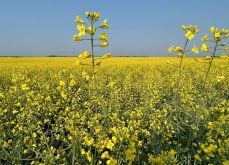BECKOM, Aus. — Canola, a made-in-Canada crop that has been boosting Canadian farm incomes for more than 30 years, is continuing to gain favour among growers in Australia.
Nick Goddard, executive director of the Australia Oilseeds Federation (AOF), says canola acreage continues to increase throughout the country as producers look for more rotational options and gravitate toward crops that offer higher returns than wheat and barley, which rank first and second in terms of overall production.
Australia’s total canola plantings were estimated at four million acres in 2010.
Read Also

Gene editing digs deeper space in Canadian plant breeding
More Canadian research into crop variety development is incorporating gene editing, and one researcher notes that Canada’s regulatory approach to gene editing will help drive innovation
Last year, seeded area rose to an estimated 4.5 million acres, a record that is likely to fall again this year, said Goddard.
“For the upcoming planting season … the expectation around the industry is that seeded acreage will certainly be up on last year,” he said.
“In a lot of areas, it’s becoming a core part of the rotation, especially in Western Australia where they don’t have too many cropping choices.”
According to AOF estimates, Australian canola growers are expected to produce a record crop of 3.3 million tonnes in 2011-12, well above earlier government estimates of 2.8 million tonnes.
Official figures from the AOF are expected later this month.
Production next year is also expected to reach record levels because of larger plantings, increased yields, better management and improved moisture profiles across much of the growing area.
Goddard said the crop is expanding further inland to areas that were once considered marginal for canola production.
The crop is also expanding north into parts of Queensland.
“If we did three to 3.5 million tonnes last year, we’ll probably do 3.5 to 3.6 this coming year, which will again be a record by a long shot.”
Canola production has presented challenges to growers, particularly in areas where rainfall is limited.
Production was estimated at 2.3 to 2.4 million tonnes in 1999, and the industry looked poised for steady growth.
However, production dropped steadily over the next seven years, hitting a low of 500,000 tonnes in 2006.
Drought took a major toll on production, and growers opted for more familiar crops with better drought tolerance.
Since then, production has been on the rebound, last year surpassing three million tonnes for the first time in the country’s history.
Close to half of Australia’s canola crop is produced in Western Australia, where yields are routinely as low 20 bushels per acre because of limited rainfall.
In other parts of the country, most notably New South Wales and Victoria, yields can routinely reach 40 bushels per acre, Goddard said.
The average yield throughout Australia last year was almost 30 bu. per acre, an exceptional number considering that average yields during the previous four years were slightly below 20 bu. per acre.
Most canola grown in Australia comes from conventional varieties. Ten percent of the crop was GM last year, which was the fourth year that GM canola was produced commercially.
Commercial cultivation of GM canola is still banned by the state government in South Australia.
Goddard said farmers have been slow to adopt GM varieties. They are still assessing the merits of the technology, he added, and are less inclined than Canadian producers to plant their entire acreage to GM varieties.
Much of the country was in the midst of a prolonged drought when the first GM varieties were introduced.
Some farmers who paid a premium for GM seed saw limited economic benefits compared to growers who used conventional varieties, which has left them questioning the merits of GM technology.
Goddard said that is likely to change as newer varieties are introduced that are better suited to Australian growing conditions.
In some cases, Roundup Ready varieties are used primarily as a weed management tool that will generate limited income but reduce weed pressure for subsequent crops.
“I guess at this stage, it’s being used tactically, in situations where farmers think it will be advantageous,” Goddard said.
“They’ll use it as they have to, rather than using it across the board.”
The Australian canola industry has had no major trade disruptions related to the commingling of GM and non-GM canola varieties.
Production of GM and non-GM canola is segregated throughout the Australian supply chain, and bulk shipments are sampled and tested according to industry-established protocols to ensure that GM content is below the approved 0.9 percent threshold.
Non-GM shipments that exceed the 0.9 percent threshold are redirected into GM markets.
The European Union represents the largest market for Australian canola, Goddard said.
Not long ago, European buyers paid a $50 per tonne premium for non-GM canola produced in Western Australia.
Australian canola that is shipped to Europe is used primarily for biodiesel production.
Non-GM varieties are required because biodiesel makers sell canola meal into European feed markets.
Mike O’Hare, a canola producer from Beckom in southwestern New South Wales, said many Australian canola growers started growing the crop primarily for rotational purposes.
However, as management practices evolved and yields improved, many farmers began to view canola as a crop with significant income earning potential.
“There’s going to be a big crop this year,” O’Hare said.
“With the price differential that we’re seeing now, it’s a very appealing alternative to wheat.”















